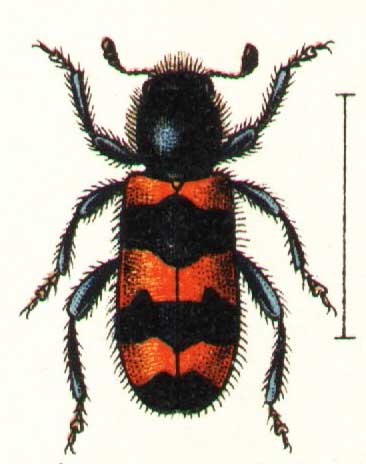
Trichodes apiarius
Superregnum: Eukaryota
Regnum: Animalia
Subregnum: Eumetazoa
Cladus: Bilateria
Cladus: Nephrozoa
Cladus: Protostomia
Cladus: Ecdysozoa
Cladus: Panarthropoda
Phylum: Arthropoda
Subphylum: Hexapoda
Classis: Insecta
Cladus: Dicondylia
Subclassis: Pterygota
Ordo: Coleoptera
Subordo: Polyphaga
Infraordo: Cucujiformia
Superfamilia: Cleroidea
Familia: Cleridae
Subfamilia: Clerinae
Genus: Trichodes
Species: Trichodes apiarius
Name
Trichodes apiarius (Linnaeus, 1758)
Synonyms
Attelabus apiarius Linnaeus, 1758
References
Primary references
Linnaeus, C. 1758. Systema Naturae per regna tria naturæ, secundum classes, ordines, genera, species, cum characteribus, differentiis, synonymis, locis, Tomus I. Editio decima, reformata. Holmiæ: impensis direct. Laurentii Salvii. i–ii, 1–824 pp DOI: 10.5962/bhl.title.542: 388. Reference page.
Links
Trichodes apiarius Taxon details on Fauna Europaea
Trichodes apiarius (L., 1758) (photo by - O.I. Boroznov)
ZooBank: 6EB35CC3-D25B-4EBD-9D6D-12FD4E2C1492
Vernacular names
čeština: Pestrokrovečník včelový
Deutsch: Gemeiner Bienenkäfer / Bienenwolf / Immenkäfer
lietuvių: Bitinis keršvabalis
Nederlands: Bijenwolf
norsk: Bikubebille
polski: Barciel pszczelarz / pszczołowiec ?
русский: Пчелиный жук-пестряк
slovenčina: Pestroš včelí
Trichodes apiarius is a beetle species of checkered beetles belonging to the family Cleridae, subfamily Clerinae.
These beetles are found in most of Europe, in the eastern Palearctic realm, and in North Africa.[1]
It is an hairy small beetle with shining blue or black head and scutellum. The elongated elytra show a bright red colour with black bands. This species can easily be distinguished from Trichodes alvearius for the black terminal band reaching the apex of elytra.
At the larval stage, these beetles are parasites of bees (hence the name “apiarius”), as the adults lay the eggs in the nests of solitary bees (Osmia and Megachile species) or in hives of honey bees, eating larvae and nymphs of their victims.
The adults grow up to 9–16 millimetres (0.35–0.63 in) and can be encountered from May through June on the flowers, mainly Apiaceae, feeding on the pollen. However, they integrate their diet with small insects that they actively hunt.
References
"Trichodes alvearius (Fabricius, 1792)". 2.6.2. Fauna Europaea. August 29, 2013. Retrieved January 23, 2015.
Retrieved from "http://en.wikipedia.org/"
All text is available under the terms of the GNU Free Documentation License

